That’s why I said, Pulsar was not only the first Bajaj-designed product but also the first successful Bajaj-designed product. ![g_109213_dapper_280x210.jpg g_109213_dapper_280x210.jpg]()
So what has changed in 17 years?
The most important thing is that we've gone from being a newcomer 17 years back to being the third biggest motorcycle maker in the world.
I still remember, just before the launch of the Pulsar, I spoke to a senior person at Kawasaki, and told them about the new motorcycle. Kawasaki was working with us for the 100cc bike at the time, because everybody thought the market was just for 100cc bikes and we wanted to be a bigger motorcycle segment. I asked him to join hands with us to develop the bigger bike, to help us to perfect it because when you are doing something for the first time, you can’t be sure of its quality. We would have branded it together, like Kawasaki Bajaj. But he said no. He said, 'you are just starting so we wouldn't know the technology, quality.' They didn’t join us. I don’t know they think of this today, but in my opinion they missed a golden opportunity. We did that alone and in 17 years from being a zero in motorcycles, we are third largest globally.
I think what we have achieved qualitatively is even bigger than being number 3 in as little as in 17 years. Because number 3 means we are ahead of Yamahas, Suzukis, Kawasakis, all European, Chinese and American makers. So qualitatively what we have achieved is that from being a company that almost never exported, 40 percent of what we make is exported today and goes to over 70 countries.
In sheer numbers, if rest of the year goes like the first five months, then it would mean 2 million vehicles in exports. This includes three-wheelers as well, but most of them [exports] are motorcycles. I would say about 1.8 0million would be motorcycles.
Exports transformed you into a global company…
Exports being 40 percent is not big but 40 percent amounting to 2 million is. I don’t know any Indian automotive or even engineering company including Maruti, Mahindra or Tata, to be anywhere near this number. In terms of percentage or production, they would be single digits and the numbers would be 20,000 or 40,000 or 60,000 [units]. We are now close to 200,000 a month.
So this kind of validation of our tech, or quality or even our cost which is reflected in the price competitiveness, attention to consumer service, customer satisfaction -- There is no one better qualitative endorsement of one’s strategy. This point is important because our strategy is not about specialisation. It’s about being a global company. ![g_109229_whenijoinedbajajin1990,waitingperiodforourscooterwas1.5years.ifanybodycoulddosomethingtoproduceonemorescooteraday,itwasabigdealforthecompany._280x210.jpg g_109229_whenijoinedbajajin1990,waitingperiodforourscooterwas1.5years.ifanybodycoulddosomethingtoproduceonemorescooteraday,itwasabigdealforthecompany._280x210.jpg]() You started your stint in Bajaj as a manufacturing engineer in December 1990…
You started your stint in Bajaj as a manufacturing engineer in December 1990…
I started working in manufacturing and I did that for five years simply because I was trained as a manufacturing engineer. When I started, believe it or not, the waiting list for our scooter was one and a half years. So if anybody could do something to produce one more scooter a day, it was a big deal in the company.
Everything I had studied at the University of Warwick in UK, had given me a lot of ideas on how to improve quality and productivity. So I enjoyed it, because you can immediately apply what you have studied and see the results. In manufacturing, you can improve the cycle time and see the result one hour later. In design, you can design something today and see the result three years later. So manufacturing has instant gratification. So I was very happy with manufacturing and I did that for five years. Soon our scooters were off the waiting period not because of the fact that we alone did a great job. It was also because after 1993, the market was moving towards motorcycles.
What was the trigger to turn Bajaj into a global company?
Sometime around 1995, I distinctly remember, I went and asked my father what do you want me to do here? I had worked in manufacturing, and I don’t know what else to do. He said to me, sitting in his office, 'do what you think is best but be best in what you do'. I asked him what he meant. What is the metric of best? He said, 'best means being a global company'.
Right now, whatever we were selling we were doing so in India. So we couldn't say we were the best in the world. If we were a global company, selling across the world and not just in Sri Lanka or Nepal, Then I could say we are one of the best. This was the first principle we acquired.
The second principle was what Sage Vasishtha said: Nothing is more powerful than doing the right thing at the present moment.
I find that many people when they speak of strategy, whether they talk globalisation or innovation, disruption or re-engineering, these are all just words. The problem is that often they forget that these words should also have context. ![g_109219_rmesancheese_280x210.jpg g_109219_rmesancheese_280x210.jpg]() So going after motorcycles was part of the global strategy?
So going after motorcycles was part of the global strategy?
When I thought about Bajaj as a global player, I observed that people have two choices. First is that you can be very market-focused and say I am going to be an Indian player. Nothing wrong in that. There are many countries that focus only on the home market or a region, and do very well. Then you can have your presence in multiple segments. This is a good strategy.
The other good strategy is to be product or segment-focused. This means that I will just do one thing. Now, how narrow or wide that one thing is depends on what your scale is or what your capacity is.
Siddhartha Lal [Royal Enfield] also does just one thing. That’s a very narrow thing: Only 350-500cc mid-sized motorcycles. I [Bajaj] am obviously wider than him [Royal Enfield] as I am going from 100cc to 400cc. Somebody might do all motorcycles, that’s even wider. But one has to realise that it’s all still in the zone of motorcycles. So this strategy [is] of being segment- or product-focused and then go to all markets.
Now why did we choose motorcycles? Because when we looked at the global basis, motorcycles were the biggest slice of the pie, scooters were smaller, mopeds were even smaller. So we said to ourselves, if we are going to sacrifice, we are not going to sacrifice the biggest one. We are going to chase the biggest one. It’s like the bank robbers saying, 'why do I rob the bank? Because that’s where the money is'.
Similarly, I am going to chase the money. In terms of sheer volumes and revenues, motorcycles are sold at higher prices than scooters, and in terms of bottom lines, motorcycles are more profitable than scooters. We said we will go after motorcycles. We will chase one thing, and we will do it really well. We will become one of the world leaders in that and then may do other things.
There are players who are into scooters as well as bikes…you don’t follow that strategy?
The mistake people make is that they try to be in all segments and in all markets. That's a disaster. Now people counter this by giving the example of Honda -- they make scooters, they make motorcycles, they cars, they even make jet skis, and yet Honda is a successful company. Nobody can deny this. Yes, it’s a successful company.
But I think what people miss is the aspect of timing. Honda started doing these things a long time back when competition was very benign. It started two-wheelers in the '40s, cars in the '60s and then something. It built its reputation and success based on that.
Now you can’t, as a newcomer, say that I am going to do what somebody did in 70s. Even a child understand that. That’s common sense. It can’t be that somebody did something 100 years back and now you will do it. That’s nonsense.
I found that companies that come up in these competitive times, to use wise words of marketing guru Al Ries, have to narrow their focus. I always tell my people, whenever they are in trouble—whether personal or professional life—or you are in a difficult situation and don’t know what to do, the starting point should be to narrow your focus. Do less. Doing more never works. ![g_109225_tweet6_280x210.jpg g_109225_tweet6_280x210.jpg]()
So has narrowing focus worked for Bajaj?
In the automotive industry, for example, it is said that in the last 60 years, only one successful brand that has come up in the world: Hyundai. Nobody else. Daewoo came and went away. Many smaller brands, and even oldies, disappeared. In our country, there is no Hindustan Motors or even Premier. It shows how difficult it is to make your presence felt in a cluttered world.
(Another crucial thing is) specialisation. What is right at the present moment for globalisation is specialisation. And how specialised [you want] to be depends on what capacity you inherit. Now with Siddhartha Lal-like capacity, you would make 200,000 motorcycles per year. But my capacity is 3 million a year. I can’t aim that small. You have to align the frontend and the backend.
That’s why we said we won’t do scooters or mopeds. We will only do motorcycles. But you just can’t do only 100cc or 150cc, you need a broad portfolio as we had three factories.
What role has market played in your shift towards motorcycles? A decade back, consumers were moving out of scooters…
You cannot go by the market. See I tell people, it doesn’t matter when it comes to junk food -- burgers and pizzas will both sell in all markets. You have to decide whether you are a Pizza Hut or a McDonald’s. Now for 10 years, scooters outpaced motorcycles. Since January this year, motorcycles are outpacing scooters. A company cannot change its strategy every 10 months. By the time you conceive and implement it, five years are gone.
So one must have the conviction. Now suppose globally motorcycles are 60 percent, scooters are 30 percent and mopeds are 10 percent. But tomorrow if somebody says the market share might become equal at 40 percent each, or motorcycles will become 40 percent or scooter 50 percent, it’s still fine by me. It doesn’t matter. At 40 percent of global volume, its still a hell lot of motorcycles.
After all the work we have done, and despite being on number 3, we have only 10 percent global market share. Sometimes, Toyota is the biggest carmaker and at times Volkswagen. Whoever is the biggest, enjoys only 10 percent [market] share. So there is no reason to feel claustrophobic at all. Even if motorcycles become 40 percent, nothing changes for us. You still have 10 percent market share and you can grow it to 15 percent or 20 or 30 percent, or more. Why does Gillette have 60 percent share and why can’t you have it? That means there is something wrong with you. Instead of [examining] taking that, you take the easy way out. This is not strategy. This is gambling.
That is why we said that we would take what is currently the biggest, most attractive and most promising slice of this pie. And first we have to get that right. Why? Let me give you an example.
How crucial was R&D in your initial journey in motorcycles?
When we started the journey 20 years back, we started designing Pulsar in 1998 the total employee strength—from watchman to the chairman—was 10,000. In Honda, R&D alone at that time was 10,000. You have to understand who are you fighting against. When you fighting a giant, it’s like a combat situation where if you are 50 versus 10,000. You don’t stand a chance.
What do you do? You narrow your focus. You put all 50 people to fight in one corner and you beat the fellows in that corner. You don’t bother about anything else.
So, we said to ourselves that we have to put every man, every minute at our disposable into motorcycle. Otherwise we would be wiped out, and we would have become like Hindustan Motors, LML, Kinetic Engineering. People forget about those who have died and gone. Strangely, for somebody like Kinetic, who was doing so well with Honda in scooters, it chased motorcycles because the country was moving to motorcycles. They should have stayed with scooters. Instead of fighting with Honda for motorcycles and losing the two-stroke scooters, they should have made a four-stroke scooter.
When you allow the outside to dictate, and winds will change directions, you will have to adjust your sail. You cannot control the wind. We would have not been around today if we had behaved like that. The reason we are still here and are going from strength to strength in overseas market is because we chose to be global we asked ourselves what was right at the present time and that was to specialise and do one big thing right.
You exited scooters but continued with three-wheelers, and now four-wheelers with Qute. Don’t you see it as a contradiction of your ‘focused’ strategy?
There are two kinds of battles or opportunity: One is mainstream battle or the large volume opportunity and the other is niche opportunity. Niche is always safer and more rewarding. Like Royal Enfield and Harley Davidson. They are in the niche, and they are doing very well.
When you come in the mainstream like a Ford or General Motors, of course there is a bigger canvas but the ocean is very red. So what we said to ourselves. As far as the red ocean is concerned, we will only go with one product. So scooter no, motorcycles yes.
Scooters can come tomorrow once we are in a strong position. That’s why we chose motorcycles. But what do we get by being a motorcycle player? We get a couple things. We get certain skills in design and engineering, manufacturing, purchasing, distribution, and we get a cost structure. With these skills and cost structure, if we can build some niche business around it like a satellite around the sun there's nothing wrong in that.
Three-wheelers are a niche business it’s a small business. Many people are of the opinion that we should not exist there. It’s neither a two-wheeler nor a four-wheeler. All kinds of opinion are there. But it doesn’t matter to us.
What happens in niche is that competitive intensity is very low. In the mainstream motorcycle segment, I have to compete with 30 people -- from the Japanese to European to Indian to Chinese to the Americans. In three-wheelers, it’s basically Piaggio. The rest of the players are insignificant. In niche, you would encounter only one or two or three players, that’s why margins are higher, and the stress is lower. That is one niche that we inherited and we are the leader. In three-wheelers, Bajaj is the number one player. In motorcycles, we are number three.
To defend that niche so that nobody else can attack us, we developed the quadricycle. So I don’t see any conflict in having a niche business which is synergistic with the main business. ![g_109217_ogrooms_280x210.jpg g_109217_ogrooms_280x210.jpg]() So the core of motorcycles is supplemented by niches?
So the core of motorcycles is supplemented by niches?
The niche business cannot be a food business which has no synergy. It has to have harmony, synergy or resonance with the skills and the cost structure. The second niche business that we started building from 2007 was the superbike. With KTM, with our 48 percent stake, we are building our second brand called Husqvarna. We are engaged with Triumph, and we are hopeful of a partnership soon. If that happens, then we would have at least three brands in that segment. This means that by far we will be the biggest premium motorcycle maker in the world.
Third niche which we see for the future is this whole area of urban mobility, where people are talking about electric vehicles, zero emissions, what’s good for the city, less congestion, shared mobility and mobility as a service. Like every company, we are also doing our own work.
Our strategy is like a triangle, where the main business is motorcycle. Then we have one niche which is intra-city, which is our three-wheeler, four-wheeler business. Then there is super bikes or pro-biking. And then there is an urbanite business or urban mobility business.
When we say that we are strong in motorcycles, exporting so much, we are very profitable, it’s important to emphasise a very important marketing principle that I learnt: 721.
How do you explain 721 marketing principle?
It’s very simple and based on human behavior. It’s not something that am trying to thrust upon someone. Let’s look at number 7. Most people can’t grasp more than seven of anything. That’s why there are Seven Wonders of the world. It’s not eight because you won't remember the eighth. Or take the seven-year itch or the fact that Snow White had seven dwarfs. She didn’t have eight. There is something about the number seven. If I ask you about the top airline brands, you won’t be able to think beyond seven, unless you spend the entire day thinking about the eight one. This happens in every segment. Whether the segment is 100cc bikes, or motorcycles, or two-wheelers, consumers will not remember more than seven brands. If you are the eight player in the market, you don’t have a chance. That’s the importance of number 7. One must be at least within the top seven.
Now next comes number 2. Jack Welch was very famous for saying in '80s that any business that General Electric is also present in, the business should either be number 1 or 2, or it will either close down or sell. The next question is, why only number 1 or 2 and not 1, 2 or 3 or only 1? The answer is, while in any segment, consumers may give a license to seven to participate, 80 percent of the revenue is made up by the top two. Almost 100 percent of the profit is made by the top 2 companies. So if you are not in the top two, you might still be there in the game but is it bringing any bread to you is the right question.
That’s why we are very particular about this. In whichever markets we enter, in a certain timeframe, we should be number 1 or number 2. In over 70 percent of our motorcycle markets globally and 87 percent of three-wheeler market, we are either number 1 or number 2. This is very important for the success in the competition.
Then comes number 1. It's a part of the principle simply because it’s best to be number 1. As marketing guru Jack Trout taught us, what is the purpose of a brand? It’s very simple. It is to dominate its category. If you have made a brand X in the mobile category, you want to dominate that category. Nobody wants the brand to be number 2, 3 ,4 or 5. You may not become number 1 but the hope is always there.
So this is the principle, we say to ourselves. We must be number 1 or number 2. It is very important for Bajaj in the motorcycle business to be number 1 or number 2. I don’t say only number 1. As long as we are either number 1 or 2, we can say that we have arrived. Then if somebody says that now we you should look at scooters, then sure. Why not.
In over 70 percent of global market, we have achieved this status. In rest of the markets where we haven't, it's because we have just entered that market. Take, for instance, Malaysia, where we have entered just 12 months back. We can’t become number 1 overnight. We are on our way though. ![g_109227_wewillexport40percentornearly2millionvehiclesthisfiscal.morethanthemarutis,mahindrasortatasofindia.thereisnobetterqualitativeendorsementofourstrategy._280x210.jpg g_109227_wewillexport40percentornearly2millionvehiclesthisfiscal.morethanthemarutis,mahindrasortatasofindia.thereisnobetterqualitativeendorsementofourstrategy._280x210.jpg]() But in India, you are a distant second in motorcycle and fourth in two-wheeler…
But in India, you are a distant second in motorcycle and fourth in two-wheeler…
India is the market where for a long time we have not been number 1. But on one hand, we are the second largest motorcycle company here. Now somebody can say that we are 4th largest two-wheeler maker, I don’t give a shit because as I was not participating here for a long time. As long as I am number 1 or 2 in my category, I am in a good place. If I am number 3 or number 4 in motorcycles in India, then I have a problem.
But at the same time one has to concede that when it is your home market, which incidentally is the biggest market in the world and you are a number 2--and not a close number 2, there is a fair distance between you and number 1. Then obviously one needs to improve. So that's the balance in my mind. Okay you are a global player, unlike Hero, but in India you need to be better.
Therefore, this is one area where we have to improve. And this is the right time to do it and we have stepped on the gas.
What makes you think that this is the right time to bring focus back to India?
If you work backwards, last two and a half years till April this year, our export business was under pressure. It had been going very well and then we had a dip for a couple of years because of oil prices and other factors that were outside our control. Now as I said, when you can’t control the winds, adjust your sails. We did that. We waited it out. A lot of people said to me, 'had we focused on India rather than running around the world, it would have been great'. But we never changed our strategy. We stayed the course. We said to ourselves, 'this is the time when exports are very strong, and we have reasons to believe that it will continue to be strong'.
Then we looked at our three wheeler business. It was doing great too. With the Permit Raj finally ending in some states, we are hitting numbers like 65,000-70,000 [units] which we hadn't in a long time.
If you look at the numbers till before August last year, typically 40,000-50,000 three wheelers [were sold], and that had even come down because exports had come down. Now if you see last six months, we are 65,000-70,000 [units]. In fact, we can sell more but we just don’t have capacity. Now this business is doing very well, exports are extremely profitable. In four-wheeler [business], we have received permission and we will crank up soon. Then, our KTM business is doing very well. Another vertical, spare parts business, is also doing very profitable.
We took a considered view in our March board meeting this year and said to ourselves that everything is doing so well, so this is the time when we must really go after the Indian motorcycle market.
Now that means not just to compete on price. That means product and promotion. For example, we have already put into more variants of Pulsar which have really done well for us since March. We introduced one variant in April and the other in May. People have not noticed it because nobody has written about it We also put in new variants of the CT, a new Avengers, and we are now going to market new Dominars.
So we have invested in product, in communication, and we have invested in sales promotion. We have invested a lot of money across all the levers—brand, product, price, marketing--and look at what has happened. We are growing in 30 percent, 40 percent, 50 percent. This is more than double the industry growth rates. While the motorcycle market share was typically around 15 percent in FY18, last month (July) our retail share was 21 percent. Clearly, the strategy is paying off. Fair enough, how far it will take us, how sustainable will it be, that only time will tell.
The Pulsar variations were at both end of the price spectrum. We had a standard Pulsar, one variant Rs 4,000-5,000 more than it [the standard variant], and the other one came in about Rs 4000-5,000 less [than the standard variant]. And they were both 150cc as it’s the biggest. The sales of the Pulsar 150s, which were earlier 28,000-29,000 units a month in the domestic market, are now around 50,000 a month and are likely to go even higher. Nobody else is growing at over 100 percent.
So our timing of looking into the domestic market is correct. We are now just narrowing our focus, and have to hit it hard as everything else is on auto pilot. That’s what (value-for-money segment) we are going after.
You recently triggered price war in the entry level segment by cutting the price of CT100. Would volume come at the cost of margin?
People have misunderstood us while talking about price war in entry segment with CT 100. It’s wrong. There is no price war. Nobody wins in a price war. The price that we have for Rs 32,000 has been there for the last two years.
So how do you explain the move to cut price and gain share?
Whether it is a 100cc bike or one-litre car, the problem is that the consumer apparently wants only a few basic things. Price, good mileage and good quality stroke, low maintenance, stroke high resale value. Resale value because it's the reflection of quality of the product.
So the problem is that unlike a Pulsar or an Avenger or Dominar, where I can put in fuel injection, LED lamps, ABS, disc brakes, here [in the 100cc value-for-money segment] I can’t do anything because technology costs money. I can put in technology, but you need to pay me for that. So this becomes difficult.
But what does one do in this situation? Simply you have one or two choices. People are buying 100cc bike as its value for money. And since there are two choices, we decided to sharply narrow our focus on two brands. The first choice is 'give motocycle, but cheaper'.
So that is the CT [for us]. It’s as a good a bike as Splendor. But the tricky part here is, if I give you the same bike for less, the question is how much less. This is where most marketers fail because people don’t change their opinion for Rs 1,000 or Rs 2,000.
For example, if you buy a car, say Maruti, for Rs 3 lakh and somebody gives you a car for Rs 2.85 lakh, you are not going to go against the herd opinion. What has Jack Trout taught us: What do people buy? People buy what other people buy because there is safety and security.
We have learnt, and this is one of our very important learnings, people will change if you give them 20 percent more advantage in anything. So 20 percent less price, 20 percent more space, 20 percent more power, 20 percent more comfort, and they will change. We deduced the price of the Hero [motorcycle], and now 20 percent less is CT.
Obviously, Hero's margin is less than 20 percent. So when we go 20 percent below Hero, it means we are losing. But that’s where rest of the business will more than compensate for what we lose in the moment. That’s one strategy: the same for less, 20 percent less. That’s why our volumes for CT100 have more than tripled.
The second game we have to play is: Same money, more bike. Somewhere you have to differentiate, either by money or by the benefit. We are already playing this game and will play it more intensely in the second half of this year with our brand called Platina, which has also grown nicely with about 35,000 motorcycles a month. But we have to do much better. If the CT can do 80,000 a month, then this should also do it.
But the problem with 'same money, more bike' is that the offering has to be 20 percent more. So we are going to launch the new Platina and go into the market with the low-cost innovation, which is relevant to the consumer and also significant. So the Platina is same money, but 20 percent more bike. I think this is, fundamentally, a very simple strategy. In the first half of this year, our target was to play out the CT. Now, the next target is to play out the Platina in the second half.
Do you plan to bring the Pulsar down from 150cc? You have done that in the past…
The Pulsar is 150cc to 220cc now. We had a 135cc in the past, we don’t do it anymore. People might say that if the Kawasaki can sell the Ninja 150 and Ninja 1200, then why we can’t? If Mercedes can sell an A class and S class, so can we. We can. But the problem is that it has to be a Pulsar.
The smaller variant of the Mercedes although prestigious, comfortable, classy, perhaps doesn’t make money for the company. As a customer, this is not her problem. But as a CEO of Mercedes, this can be a headache. To be a Mercedes, it has to have the material, finishes, performance, fixed cost, and then selling at lesser price tag won’t make sense.
Similarly, people would love to have a 125cc Pulsar, but for us it won’t be very attractive. So we must create different brands in that space. What's next for Pulsar, I can say that it is very well set now. With all Pulsars, we are already doing almost 70,000 a month domestically. And I would guess we are doing another 30,000-35,000 Pulsars as exports per month. It means over 100,000 Pulsars a month. This is massive volume. ![g_109223_teslabajaj_280x210.jpg g_109223_teslabajaj_280x210.jpg]() Has Pulsar changed much since its roll out in 2001?
Has Pulsar changed much since its roll out in 2001?
It has not changed enough. But that’s true for other brands from other companies as well. Though Pulsar has evolved nicely, it’s time for a complete refresh and an all new Pulsar. I think in 2020, when new emission norms come, that would be a great opportunity to go to market with a product that is not only much greener but also in a new avatar. We are working on that. In 2020, we should have an all new range of Pulsars and Avengers. Unlike in the 100cc segment where it is a two-horse race between Hero and Bajaj who have 90 percent of the segment with them, in this segment, we have 40 percent market share, another 17-18 percent each is with TVS and Honda, Yamaha has 15 percent.
Once your blockbuster in 125cc, the Discover seems to be losing its steam…
I don’t think we can do much with it [Discover] in the domestic market. We still do about 400,000 Discovers, including exports, a year. That’s not a small number. But once a brand falls out of favour with the consumers in the domestic market, there is no point pushing it.
Our understanding [of the fall of Discover] is that it has nothing to do with the product but is because of dilution in the positioning. The Discover was country’s first 125cc motorcycle. We also successfully introduced a 100cc Discover. It did very well. But for the longest time, the communication was all about the 125cc Discover. Why? Because differentiation should be there. If Hero was 100cc, we had 20 percent more in Discover 125cc. We were actually 25 percent more. The moment we said 125cc, consumers knew the product was different.
Being reasonably fuel efficient, we never said it was most fuel efficient. Discover is such a joy to ride. It was not a Pulsar or Avenger, that are too big or too fast to ride. This was the positioning of Discover.
When we shifted our message to the 100cc, that’s where the problem started. Marketing is the process of taking the salesman out of sales. The biggest mistake is to listen to sales, which means you had to pursue numbers. Though intention was good but as they say road to hell is paved with good intention. But in pursuit of numbers, we lost the positioning. Mercedes may make the A class. But how many times would they advertise it? The communication will always be E class or SUV. The positioning is best or nothing. With one small Mercedes, you can’t keep on saying best or nothing. So the problem was that when we put out a 100cc Discover, the credibility of its positioning got compromised. It’s a fun to ride bike. Not a sports bike or a boring bike. This position got diluted.
Unfortunately, positioning is a matter of perception. While performance comes from product, perception comes from positioning. Performance I can measure. We never had such issues with Discover. There was never a product performance issue. But there was a positioning perception issue. When a brand’s aura starts getting diluted, it is very difficult to measure it. Ultimately, you get to know when the sales starts falling. But by that time it’s too late. The single biggest crime in marketing, in the words of Al Ries and Jack Trout, is line extension or brand extension. That’s why this is the biggest danger of launching a Pulsar 125 or 135. Logically, I can argue that if a Merc can do, so can I. But when a Merc does it, it draws a neat line between what to do and what to not do. It’s very important to know otherwise it becomes a case of 'fools rushing in where angels fear to tread'. So If I do that and say if Merc does it, I too will do it, then a Discover will happen.
In domestic market, sales, greed or ambition proved to be [our] undoing. If you are communicating 125cc and selling 100cc, imagine the numbers you could churn if you show 100cc and then sell so many 100cc. With this thinking you lose everything. This is what happened.
But most of the people won’t understand this story, so they would come up with their own versions, like Bajaj has stopped making Discover or it has become expensive, or there is some issue with the product. Then the brand gets sullied completely and lose out. Even if I try to bring it back, and anything is possible, but the chances of success are very slim to be honest. It seems as if to start a new brand is riskier, but actually that’s a safer option. With less effort and money you can create a new brand. That is what we will do.
Right now, we are focused on the CT 100 and Platina on one hand, and the rest is the sports bike, including Pulsar, KTM, Dominar. But there will mid-space and we, as a motorcycle maker, shouldn’t miss out on this space where we were the market leader at one point of time with Discover. This is one rare example where a market leader trips.
And that’s fine. As a marketing company, you should get nine out of 10 right. So we have to find a new solution to this space.
So any plans to take Platina into the 125cc segment to make up for Discover?
Taking Plating to this space (125cc) will again dilute the brand. Consumers first see what you communicate, what the word of mouth is, and what their own experience is. If Platina is known as a very fuel efficient and comfortable motorcycle, I will keep communicating that. In this case, how would consumers to know that there is a 125cc. If I suddenly try to communicate 125cc, I will lose the original positioning based on perception. So Platina will not work here. It will be a mistake. We would be making a Discover mistake. You have to create a new brand.
Don’t you agree that you miss out on a chunk of the two-wheeler market by not being present in scooters?
Very few companies are candid about accepting that we missed out on a part of the market. Look at Hero, they cover this side very well. We are missing out on mid segment 125cc, I think it’s about 2.5 lakh bikes a month. It’s not small. If you have 20 percent share there, it gives you a considerable number. Certainly we are missing out on a big slice and we have to make up for that with a new brand which we are working on. But look at Hero, the sports segment is close to 200,000, there they are virtually zero. Exports out of India alone are 200,000 bikes a month, out of which we alone account for 140,000 units. So in this 400,000 motorcycles segment, Hero is virtually zero. They might say that they make scooters, but scooters is also again 400,000 units. Look at TVS. They do well in sports segment, they do well in exports as well. But they completely miss out on 100cc, which is 700,000 a month. They are participating in scooters. So they focus on scooter and miss out on the 100cc segment. Now how does that make any sense?
People say that Yamaha makes scooters, but they neither export nor sell in the entry level or mid segment. It means they lose out on the 900,000 units segment. They are only in the 200,000 units sports segment. I am not saying it’s wrong. Maybe it’s the right thing for them as they have narrowed their focus. But they miss out on 700,000 units segment of 100 to 125 cc bikes, they miss out on exports. So every company will miss out on something and every company has to ask itself how to cover it up.
We are not vacating this 125 segment. We are working on a new product and will cover it up. But my point is why to leave gaps in motorcycle portfolio and think about scooters.
What’s your take on shared mobility in two-wheeler space?
That’s a different story. I am not very convinced about sharing business as far as two-wheelers are concerned. I think two-wheelers are not very expensive to own. A car is Rs 5 lakh. A two wheeler is Rs 50,000 or Rs 1 lakh. Secondly, in terms of parking, even an average person has parking space for one or two two-wheelers. Cars are a different thing. The pain that cars have, of high running and purchasing cost and nuisance for parking, this pain is not there in two-wheeler for large extent and even for three-wheeler. For cars, I see a big motivation in sharing. Some people even say that they would never own a car as they can get Uber or Ola in two minutes. This makes sense in a city like Bengaluru, where it takes half an hour to go two kilometres.
Now if somebody owns a nice electric or petrol two wheeler, why should she go for sharing? Am not very clear. She may call a car from Ola or Uber to go to airport, but that’s not my market. I don’t have to worry about that.
What are your plans for electric urban mobility?
When we develop an electric two-wheeler, whether bikes or scooters or mopeds or bicycles, it will be a Tesla-like business. This brand will be purely electric. The best solution is when the brand itself is electric. Toyota is not an electric brand. It’s a petrol, diesel brand also making electric vehicles. But with Tesla, it’s not the case. You would be aghast if tomorrow Tesla launches a petrol Tesla.
I think the most important thing in urban mobility is to create an urban mobility brand because people don’t buy batteries. You buy an Apple or Samsung, you don’t buy batteries. This urban mobility from us would definitely be disruptive. Quadricycle might be new as a product, but the technology that goes into it is the same. But this [urban mobility] is completely new. So it’s a big learning for us. We will take small steps. First we have to be aspirational, have to be in the two-wheeler space electric will be expensive, will not sell millions, but definitely this is not something that a company can miss out on. You can’t just sit back and do nothing. In fact, nothing may happen for 10 years, but when it does, you would be left out. One has to start early.

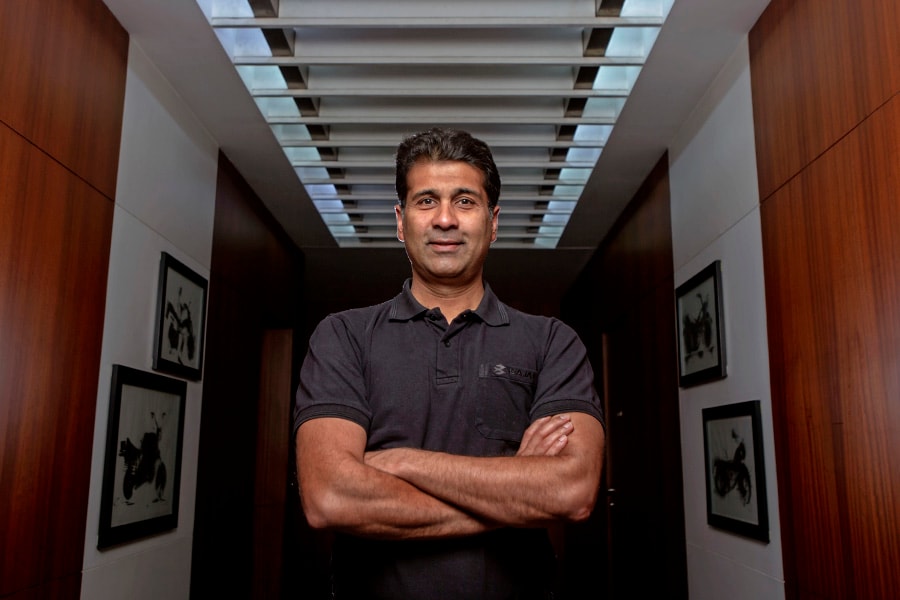 Rajiv Bajaj, Managing Director, Bajaj Auto
Rajiv Bajaj, Managing Director, Bajaj Auto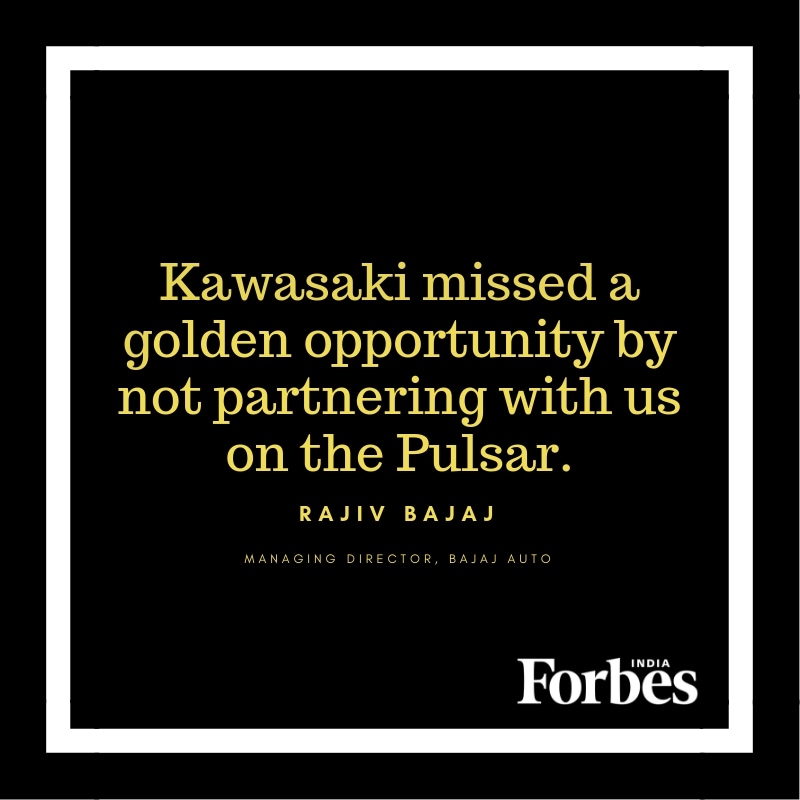
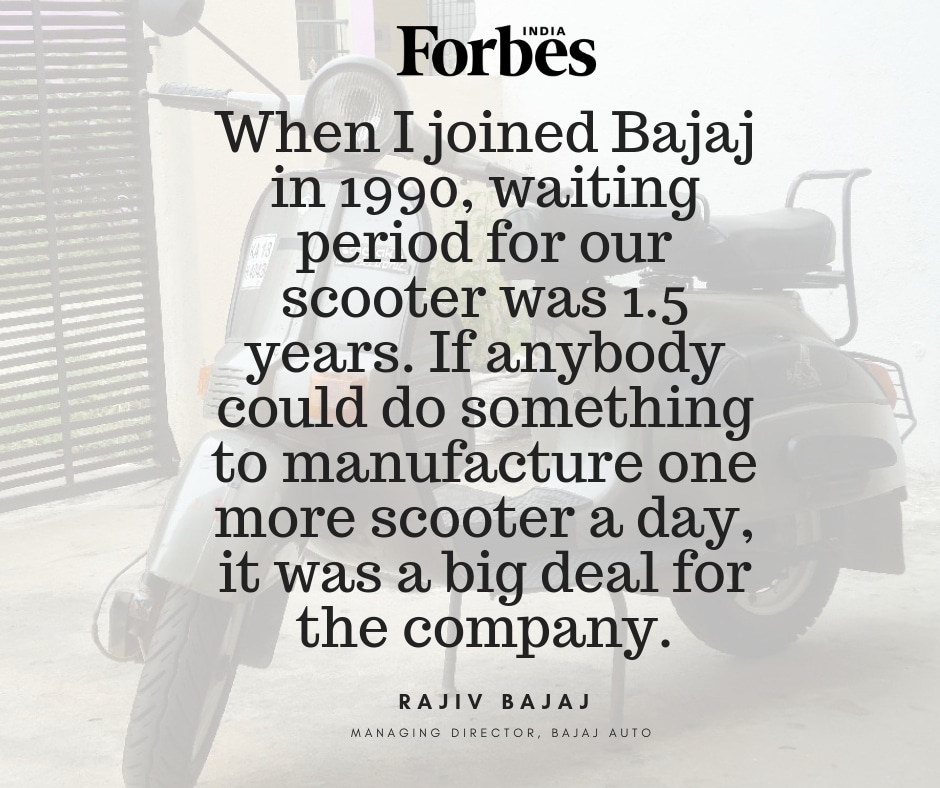 You started your stint in Bajaj as a manufacturing engineer in December 1990…
You started your stint in Bajaj as a manufacturing engineer in December 1990…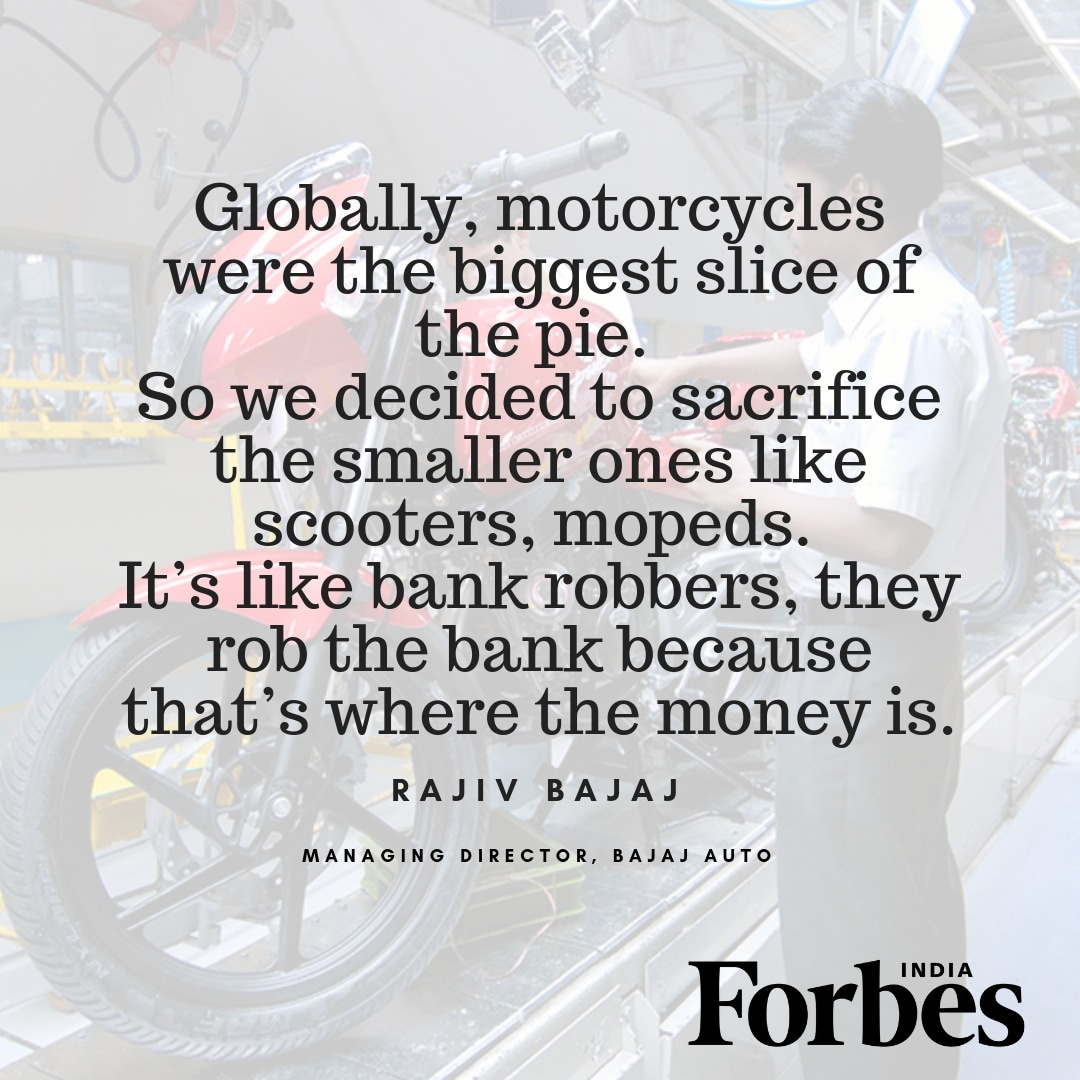 So going after motorcycles was part of the global strategy?
So going after motorcycles was part of the global strategy?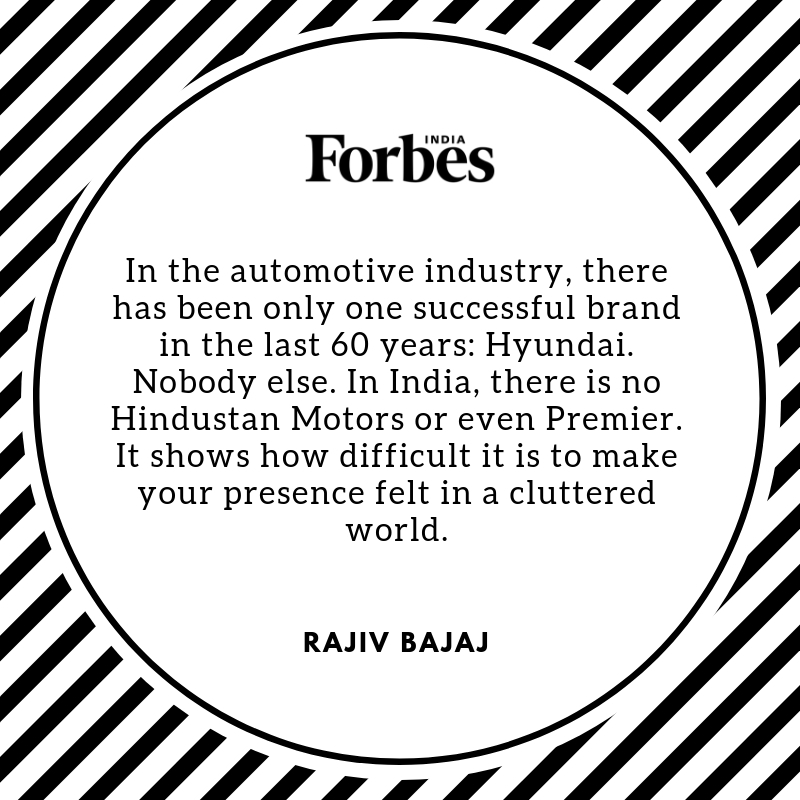
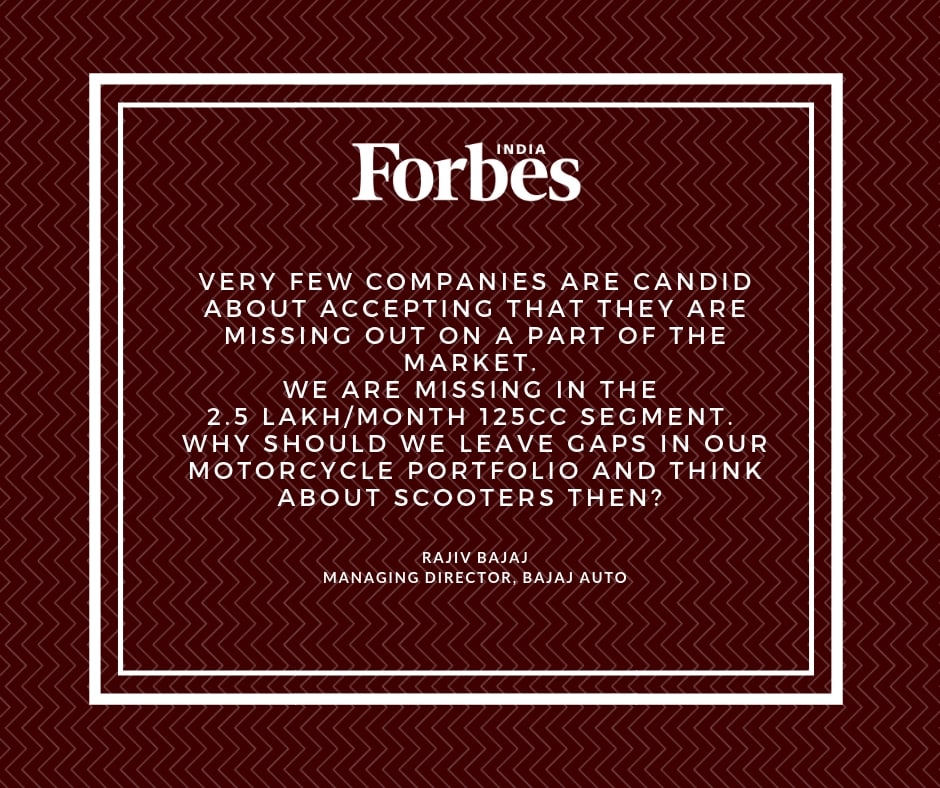 So the core of motorcycles is supplemented by niches?
So the core of motorcycles is supplemented by niches? 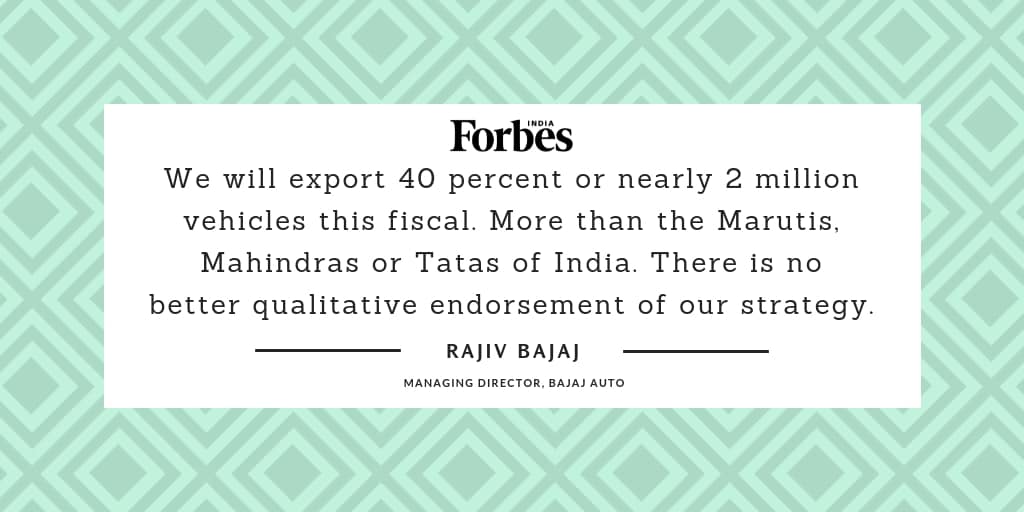 But in India, you are a distant second in motorcycle and fourth in two-wheeler…
But in India, you are a distant second in motorcycle and fourth in two-wheeler… Has Pulsar changed much since its roll out in 2001?
Has Pulsar changed much since its roll out in 2001?